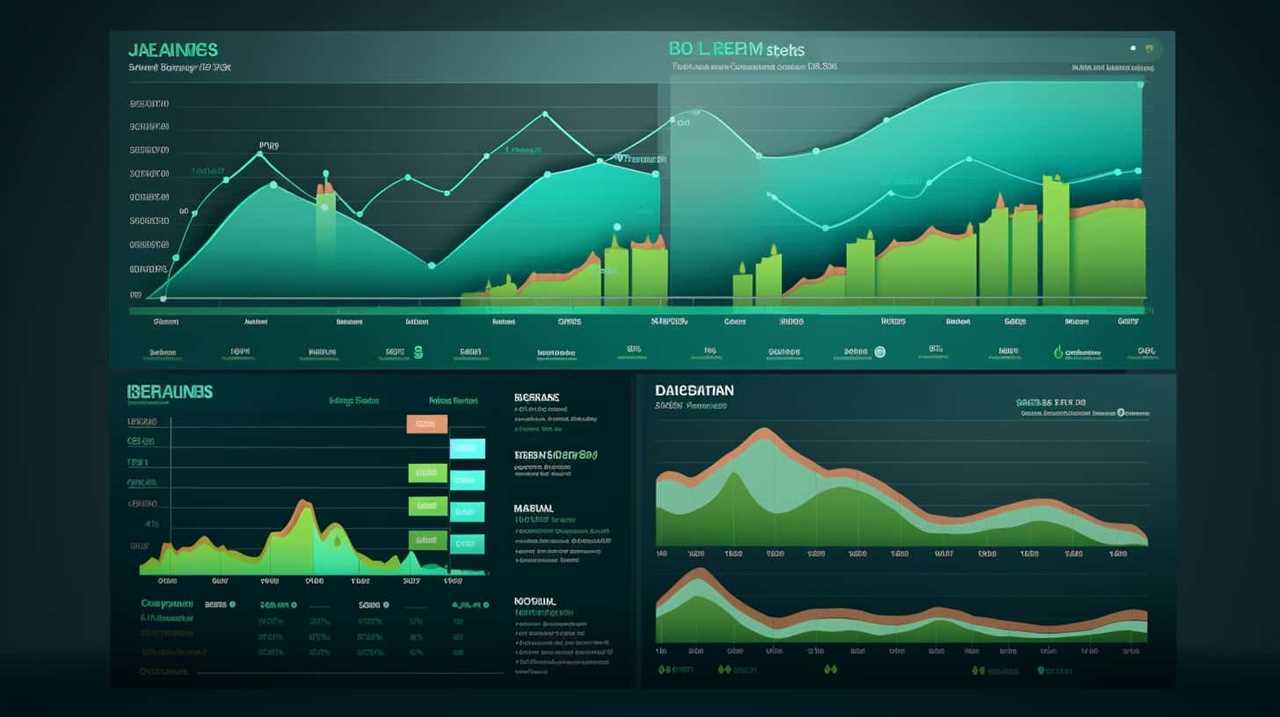Are you prepared to elevate your microbrewery to new heights?
We’ve brewed up a winning recipe for success with our Google Ads strategies. From understanding the market to crafting compelling ad copy, we’ll guide you through every step.
Our team of experts has hopped on the latest trends and optimized landing pages for maximum conversions.
Get ready to raise a glass to increased visibility, repeat business, and measurable success.

Let’s pour our knowledge into your success story.
Key Takeaways
- Conducting a competitive analysis is crucial for identifying direct competitors, assessing strengths and weaknesses, and uncovering untapped opportunities in the microbrewery market.
- Understanding the demographics, interests, and behaviors of potential customers is essential for tailoring advertising campaigns and effectively reaching the target audience.
- Strategic keyword selection, monitoring keyword performance, and incorporating long tail keywords are important for optimizing Google Ads campaigns and targeting specific customer segments.
- Crafting compelling ad copy, optimizing landing pages for conversions, and utilizing ad extensions enhance visibility, drive action, and improve overall campaign performance for microbreweries.
Understanding the Microbrewery Market
We’ve delved into the microbrewery market, and it’s crucial to understand its intricacies. As craft beer trends continue to rise, competition among microbreweries has become fierce. To navigate this landscape successfully, a comprehensive competitive analysis is essential.
Craft beer trends are constantly evolving, influenced by consumer preferences, cultural shifts, and emerging market demands. Understanding these trends allows microbreweries to stay ahead of the curve and cater to their target audience’s evolving tastes. Whether it’s the demand for hazy IPAs, sour beers, or experimental flavors, keeping a finger on the pulse of the craft beer scene is paramount.
Conducting a competitive analysis enables microbreweries to identify their direct competitors, assess their strengths and weaknesses, and uncover untapped opportunities. By evaluating factors such as product quality, branding, pricing strategies, distribution channels, and customer experiences, breweries can gain valuable insights into how to differentiate themselves in a crowded market.

Crafting a strategic plan based on the findings of the competitive analysis is essential for microbreweries aiming for mastery in the industry. This involves leveraging the unique aspects of their brand, identifying their unique selling propositions, and targeting specific customer segments. By aligning their marketing efforts with consumer preferences and market trends, microbreweries can position themselves as leaders in the craft beer scene.
Identifying Your Target Audience
As we move forward in our discussion on Google Ads strategies for microbreweries, it’s crucial to identify our target audience. By understanding the demographics and interests of our potential customers, we can tailor our advertising campaigns to reach the right people at the right time.
In addition, employing market segmentation techniques allows us to divide the market into distinct groups, enabling us to craft personalized messages that resonate with each segment.
Lastly, audience profiling strategies help us gain deeper insights into our target audience’s behaviors, preferences, and motivations, enabling us to create highly targeted and effective ad campaigns.

Demographics and Interests
To effectively target your audience, we must delve into the demographics and interests of potential customers for your microbrewery.
Demographics analysis allows us to understand the characteristics of your target market, such as age, gender, location, and income level. This information helps us create tailored marketing campaigns that resonate with your potential customers.
Moreover, interest-based targeting enables us to reach individuals who’ve shown an interest in craft beer, brewing, or related topics. By leveraging this data, we can ensure your ads are displayed to the right people at the right time, increasing the likelihood of engagement and conversion.
Understanding your target audience’s demographics and interests is crucial for a successful Google Ads strategy, as it allows us to maximize your marketing budget and deliver impactful messages to the right individuals.

Market Segmentation Techniques
To effectively identify your target audience, we employ market segmentation techniques that allow us to divide potential customers into distinct groups based on their characteristics and preferences.
One such technique is behavioral targeting, which involves analyzing the online behavior of users to understand their interests, preferences, and purchasing patterns. By leveraging data from platforms such as Google Ads, we can create targeted campaigns that resonate with specific segments of our audience.
Additionally, geographical segmentation strategies play a crucial role in reaching the right customers. By understanding the demographics, cultural nuances, and preferences of different regions, we can tailor our marketing efforts accordingly. This approach ensures that our messages are relevant, impactful, and drive higher engagement and conversions.
Audience Profiling Strategies
We employ audience profiling strategies to identify our target audience for our Google Ads campaigns. By utilizing behavioral targeting tactics, we can analyze the online behaviors and preferences of potential customers. This allows us to tailor our ads to specific segments of the market who are most likely to be interested in our microbrewery products.

One of the key strategies we use is social media advertising. Through platforms like Facebook and Instagram, we can reach a wide range of individuals who’ve shown an interest in craft beer or related topics. By leveraging the data provided by these platforms, we can further refine our audience profiling and target our ads to those who are most likely to convert into customers.
Audience profiling is a crucial step in optimizing our Google Ads campaigns. By understanding the demographics, interests, and online behaviors of our target audience, we can create highly targeted and effective advertisements. This not only increases the likelihood of conversions but also maximizes our return on investment.
Selecting the Right Keywords
When it comes to selecting the right keywords for our microbrewery’s Google Ads campaign, strategic thinking is key. We need to align our chosen keywords with our target audience to ensure our ads reach the right people at the right time.
Once our campaign is live, it’s crucial to monitor the performance of our keywords and make adjustments as needed to optimize our results.

Strategic Keyword Selection
In order to maximize the effectiveness of our Google Ads campaigns, we must carefully select the right keywords for our microbrewery. Strategic keyword selection involves conducting a competitive analysis to identify the keywords that will give us a competitive edge. By understanding what keywords our competitors are targeting, we can refine our keyword selection strategy. Additionally, we should focus on incorporating long tail keywords, which are more specific and have less competition. These keywords may have lower search volume but can attract highly targeted traffic to our microbrewery website. To illustrate this concept, consider the following table:
| Competitor Keywords | Refined Keywords |
|---|---|
| Craft beer | Craft beer styles |
| Microbrewery | Local microbrewery |
| Beer tasting | Craft beer tasting events |
Target Audience Alignment
To effectively align with our target audience, we must carefully select the right keywords using a strategic approach.
When it comes to reaching niche audiences, behavioral targeting techniques are essential. These techniques allow us to understand the online behaviors and preferences of our target audience, enabling us to create relevant and engaging ads that resonate with them.
By analyzing data such as search history, browsing patterns, and social media interactions, we can identify the keywords that will attract the attention of our desired audience. This strategic keyword selection ensures that our ads are displayed to the right people at the right time, maximizing our chances of conversion.

Monitoring Keyword Performance
By monitoring the performance of our selected keywords, we can ensure that our Google Ads campaigns for microbreweries are optimized for success.
Keyword research is a crucial step in this process, as it allows us to identify the most relevant and effective keywords for our target audience.
Once we’ve selected the right keywords, we need to closely monitor their performance metrics to gauge their effectiveness.
This involves tracking metrics such as click-through rates, conversion rates, and cost per click.

By analyzing these metrics, we can identify which keywords are driving the most traffic and conversions, and make informed decisions on where to allocate our budget and resources.
Regular monitoring and analysis of keyword performance is key to ensuring the success of our Google Ads campaigns for microbreweries.
Crafting Compelling Ad Copy
Crafting compelling ad copy requires understanding the target audience and tailoring our messaging to resonate with their desires and preferences. In the world of Google Ads, where competition is fierce and attention spans are short, it’s crucial to grab the viewer’s attention and compel them to take action. To achieve ad copy effectiveness, it’s essential to test different variations and analyze the results.
When crafting ad copy, we must first identify the key desires and preferences of our target audience. What do they value in a microbrewery? Is it unique flavors, locally sourced ingredients, or a cozy atmosphere? By understanding their motivations, we can create ad copy that speaks directly to their desires.

Once we’ve a clear understanding of our audience, it’s time to test different ad copy variations. We can experiment with different headlines, descriptions, and calls-to-action to see which ones resonate the most. A/B testing allows us to gather data on ad copy performance and make data-driven decisions.
Analyzing the results of our ad copy testing is crucial for improving our campaigns. We can identify which variations generate the highest click-through rates, conversions, and ultimately, sales. By continuously iterating and optimizing our ad copy based on data, we can maximize our advertising budget and drive the highest possible ROI.
Crafting compelling ad copy is an ongoing process that requires creativity, analytical thinking, and strategic decision-making. By understanding our target audience and continuously testing and optimizing our messaging, we can create ads that captivate and convert.
Optimizing Landing Pages for Conversions
When optimizing landing pages for conversions, we focus on enhancing the user experience and driving action. The design of visuals plays a crucial role in capturing the attention of visitors and enticing them to take the desired action. By using high-quality images and videos that showcase the unique aspects of your microbrewery, you can create a visually appealing and immersive experience for your audience. A well-designed landing page can evoke emotions such as excitement, curiosity, and desire, making visitors more likely to engage with your brand.

A/B testing is another essential strategy for optimizing landing pages. By creating different versions of your landing page and testing them against each other, you can gather valuable insights about what resonates with your audience and drives conversions. Testing different headlines, calls to action, and layout variations can help you identify the most effective elements for driving action.
Utilizing Ad Extensions for Enhanced Visibility
To enhance the visibility of our microbrewery, we can utilize ad extensions that complement our Google Ads strategies. Ad extensions are additional pieces of information that can be included in our ads, providing more value and increasing the chances of attracting potential customers. By implementing ad extension best practices, we can maximize our ad visibility and stand out from our competitors.
One of the most effective ad extensions to consider is the sitelink extension. This allows us to include additional links to specific pages on our website, such as our beer selection, brewery tours, or online store. By providing these direct links, we can guide users to the most relevant information and increase the likelihood of conversions.
Another valuable ad extension is the call extension. With this, we can include our phone number directly in the ad, making it easy for customers to contact us with any inquiries or to place an order. This can be especially useful for customers who prefer to speak with someone directly.

Utilizing ad extensions not only provides more information to potential customers but also takes up more space on the search results page, increasing our overall ad visibility. By following ad extension best practices and carefully selecting the extensions that align with our goals, we can enhance our microbrewery’s visibility and attract more customers.
Monitoring and Adjusting Campaign Performance
As we continue to optimize our Google Ads strategies, it’s crucial to regularly monitor and adjust the performance of our campaigns. Campaign optimization is a continuous process that requires careful data analysis and strategic decision-making.
Here are three key steps we can take to effectively monitor and adjust the performance of our campaigns:
- Set clear goals: Before diving into data analysis, it’s important to establish specific goals for each campaign. Whether it’s increasing website traffic, improving conversion rates, or boosting brand awareness, clearly defined goals will guide our monitoring and adjustment efforts.
- Analyze campaign data: Regularly reviewing campaign data is essential for identifying areas of improvement. From click-through rates to conversion rates, analyzing key metrics will provide valuable insights into the performance of our campaigns. By identifying trends and patterns, we can make data-driven decisions to optimize our campaigns.
- Make data-driven adjustments: Based on our data analysis, we can make informed adjustments to our campaigns. This could involve tweaking ad copy, adjusting bidding strategies, or targeting specific demographics. By using the insights gained from our data analysis, we can optimize our campaigns to drive better results.
Leveraging Remarketing to Boost Repeat Business
To boost repeat business, we can leverage remarketing as a powerful strategy to engage with potential customers who have previously interacted with our microbrewery’s website or online ads. Remarketing allows us to stay top-of-mind and remind customers of our brand, enticing them to come back for more. By utilizing social media for brand building, we can reach a wider audience and showcase our unique offerings, creating excitement and curiosity. We can create targeted ads on platforms like Facebook and Instagram, showing personalized content to users who have already shown interest in our microbrewery.

Implementing email marketing for customer retention is another effective way to boost repeat business. We can send personalized emails to our customer database, offering exclusive discounts, new product announcements, and event invitations. By staying in touch with our customers and providing them with valuable content, we can strengthen their loyalty and encourage them to continue supporting our microbrewery.
To further illustrate the potential impact of leveraging remarketing, let’s take a look at the following table:
| Remarketing Strategy | Benefits | Examples |
|---|---|---|
| Social Media Ads | Increased brand visibility | Facebook ads featuring our beer |
| Targeted reach | Instagram ads showcasing events | |
| Enhanced customer engagement | Twitter polls for beer preferences | |
| Email Marketing | Personalized communication | Exclusive discounts for subscribers |
| Customer retention | Monthly newsletters with updates | |
| Increased customer loyalty | Customized birthday offers |
Measuring Success With Conversion Tracking
We can measure the success of our remarketing strategies and track conversions to determine the effectiveness of our marketing efforts. Conversion tracking allows us to gather valuable data and insights that can help us optimize our campaigns and maximize our return on investment.
Here are three key ways in which conversion tracking can benefit our microbrewery:

- Improved targeting: By tracking conversions, we can identify which keywords, ads, and audience segments are driving the most conversions. This information enables us to refine our targeting strategy, ensuring that our ads reach the right people at the right time.
- Optimized ad spend: Conversion tracking allows us to analyze the cost per conversion for each campaign, ad group, and keyword. Armed with this information, we can allocate our ad spend more effectively, focusing on the campaigns and keywords that yield the highest return on investment.
- Data-driven decision making: Conversion tracking provides us with valuable data on customer behavior, such as the actions they take after clicking on our ads, the devices they use, and the time it takes for them to convert. This data can inform our decision-making process, allowing us to make data-driven adjustments to our campaigns and website to improve conversion rates.
Frequently Asked Questions
How Can Microbreweries Effectively Compete With Larger Breweries in the Market?
To effectively compete with larger breweries in the market, microbreweries can utilize local marketing and social media advertising. By targeting specific demographics and engaging with customers online, microbreweries can carve out a niche and build a loyal customer base.
What Are Some Unique Challenges That Microbreweries Face When It Comes to Advertising?
Unique marketing challenges for microbreweries include limited advertising budgets and fierce competition from larger breweries. Despite these obstacles, strategic and creative approaches can help us overcome these challenges and achieve success in our advertising efforts.
Are There Any Specific Strategies or Tips for Targeting a Local Audience With Google Ads?
When it comes to targeting a local audience with Google Ads, there are specific strategies and tips we can employ. By using local targeting and geographic keywords, we can ensure our ads reach the right people in the right location.
How Can Microbreweries Ensure That Their Landing Pages Are Optimized for Conversions?
To optimize landing pages for conversions, microbreweries should focus on clear messaging, compelling visuals, and a seamless user experience. By conducting A/B testing and analyzing data, we can continually refine and improve our conversion rate optimization strategies.

What Are Some Best Practices for Utilizing Ad Extensions to Enhance the Visibility of Microbrewery Ads?
To maximize ad visibility and improve click through rates, we recommend utilizing ad extensions strategically. By incorporating additional information and calls to action, we can enhance the visibility of microbrewery ads and drive more conversions.
Conclusion
In conclusion, by implementing effective Google Ads strategies, microbreweries can successfully reach their target audience, increase visibility, and drive conversions.
With a deep understanding of the market, carefully selected keywords, compelling ad copy, and optimized landing pages, microbreweries can stand out in a competitive industry.
The use of ad extensions and remarketing techniques further enhances visibility and boosts repeat business.

By closely monitoring and adjusting campaign performance, and measuring success through conversion tracking, microbreweries can continue to grow and thrive in the craft beer market.
Cheers to brewing success!










